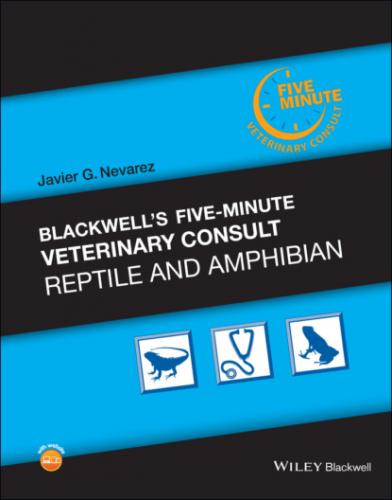Nutritional support should be provided as needed only when the reptile is well hydrated and at an ideal environmental temperature for the species.
An esophagostomy tube should be considered for long‐term care.
CLIENT EDUCATION/HUSBANDRY RECOMMENDATIONS
Quarantine: the current recommendation is for approximately 6 months isolation period for most reptiles, with PCR testing at various intervals.
Post‐outbreak: after diagnosis of an adenovirus infection in a collection, cages and hard surfaces should be thoroughly cleaned with a detergent, followed by disinfection with a 10% bleach solution. A minimum of 10‐minute contact time with the bleach is recommended. All bleached supplies and cages should be thoroughly rinsed afterward and dried. Bleach can be corrosive and can cause respiratory irritation in enclosed spaces.
Direct unfiltered sunlight or other intense ultraviolet sources may also aid disinfection. Proper contact time must be followed if using other disinfectants.
All reptiles should be kept at appropriate temperature and humidity and offered food consistent with their dietary requirements.
DRUG(S) OF CHOICE
N/A
PRECAUTIONS/INTERACTIONS
N/A
PATIENT MONITORING
Reptiles showing clinical signs should be isolated and provided supportive care.
Any co‐infections should be treated, if possible.
Monitoring weight, appetite, and fecal production will help assess response to therapy and progression of infection.
Utensils and cage furniture should not be transferred from room to room or animal to animal.
EXPECTED COURSE AND PROGNOSIS
There is no specific treatment.
Disease progression is unknown as antemortem diagnosis is seldom determined.
Cases have ranged from acute to chronic protracted presentation of clinical signs.
Identifying adenovirus from a healthy animal is not diagnostic for a disease caused by the virus.
Reptiles can be inapparent hosts for adenoviruses.
COMMENTS
N/A
ZOONOTIC POTENTIAL
N/A
SYNONYMS
N/A
ABBREVIATIONS
AdV = Adenovirus
PCR = polymerase chain reaction
PCV = packed cell volume
TEM = transmission electron microscopy
INTERNET RESOURCES
Kik, MJL. Adenoviris infection in reptiles. Transmissible Diseases Handbook. 4th ed. European Association of Zoo and Wildlife Veterinarians. https://www.eazwv.org/page/inf_handbook
Jacobson E, Wellehan J, Stacy B. Reptile Adenovirus PCR and Sequencing at the University of Florida CVM. www.dachiu.com/beardeddragons/Adenovirus.pdf
Suggested Reading
1 Doszpoly A, Wellehan J.F.X. Jr., Childress AL, et al. Partial characterization of a new adenovirus lineage discovered in testudinoid turtles. Infect Genet Evol 2013; 17:106–112.
2 Papp T, Fledelius B, Schmidt V, et al. PCR‐sequence characterization of new adenoviruses found in reptiles and the first successful isolation of a lizard adenovirus. Vet Microbiol 2009; 134(3–4):233–240.
Author Drury R. Reavill, DVM, DABVP (Avian and Reptile & Amphibian Practice), DACVP
Anemia
DEFINITION/OVERVIEW
Anemia is a sign of disease and is characterized by a decreased number of erythrocytes, hemoglobin deficiency or both. It can occur due to one of four main categories: decreased erythropoietic activity, hemorrhage, destruction of red blood cells, or sequestration.
ETIOLOGY/PATHOPHYSIOLOGY
Traumatic
Hemorrhagic
Maladaptation syndrome associated anemia: reported in stressed reptiles, associated with captivity or with capture of wild reptiles
Blood parasites
Virus associated anemia
Autoimmune hemolytic anemia: rare in reptiles
SIGNALMENT/HISTORY
Wild‐caught reptiles or those housed under poor husbandry conditions may be more predisposed.
CLINICAL PRESENTATION
Nonspecific clinical signs including lethargy, anorexia, and behavioral changes.
Pallor of skin and mucus membrane color may also be observed.
RISK FACTORS
Husbandry
Inadequate husbandry, including diet, is often a predisposing factor for many diseases of captive reptiles.
Any reptile maintained under poor husbandry conditions should be considered susceptible to disease.
Wild‐caught reptiles are more likely to have underlying diseases, especially endoparasites and hemoparasites, which may be the underlying cause of chronic anemia.
Others
Any reptile with a chronic illness may be predisposed to anemia.
DIFFERENTIAL
